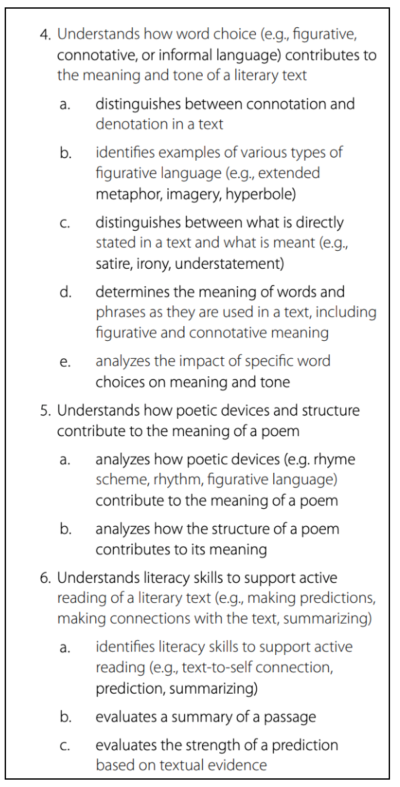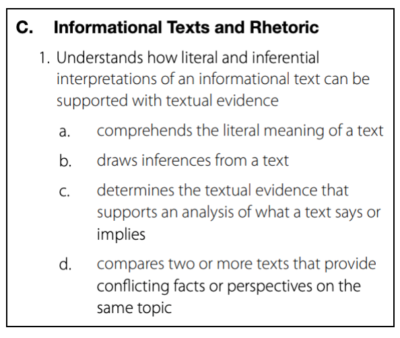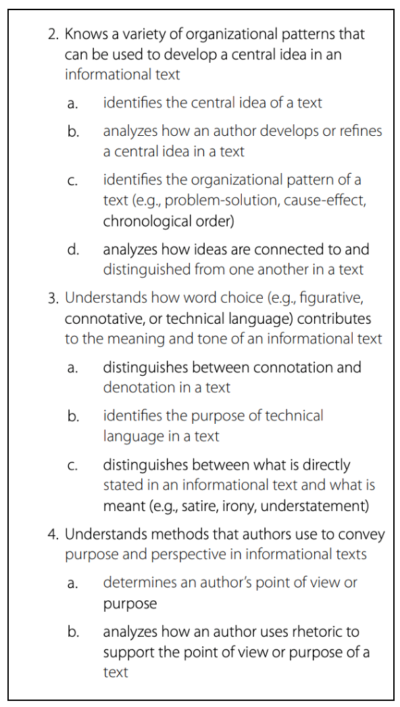Praxis®️ Middle School ELA Category I: Reading
Overview
The Reading content category has 50 selected-response questions and 1 constructed-response item. These questions account for 46% of the entire exam.
This content category can be neatly divided into 3 sections:
- General Knowledge
- Literature
- Informational Texts and Rhetoric
So, let’s talk about the General Knowledge section first.
General Knowledge

This section tests your general knowledge of literature, genres, and subgenres.
Let’s talk about some concepts that you will more than likely see on the test.
Haiku
A haiku is a Japanese poem that typically focuses on nature (specifically seasons) and has seventeen syllables. Line one has five syllables, line two has seven syllables, and line three has five syllables. Haikus do not contain similes or metaphors. Example:
Spring morning marvel
lovely nameless little hill
on a sea of mist
-Basho (1644-94)
Charles Dickens (1812-1870)
Charles Dickens was an English author (perhaps one of the greatest of the Victorian time period) whose stories and characters are still widely read about today.
Dickens wrote a total of 15 novels and five novellas, along with many short stories. Some of the most well-known works include:
- A Christmas Carol– The main character, Ebenezer Scrooge, was an old man who was known for being mean and miserable. On Christmas Eve, he is visited by the ghosts of Christmas past, present, and future. The ghosts show him different aspects of his life. This leads him to be more understanding, kind, and generous.
- Oliver Twist– Oliver Twist is a young orphan who is sent to a workhouse in London. He escapes the workhouse and meets Artful Dodger, who is a leader of a gang of young thieves. Oliver learns how to pickpocket. He finds he does not like to steal, so he runs away. He is taken in by a victim of the boy’s stealing but is then taken back by leaders of the gang. Oliver is shot in a robbery but is then taken in by the woman whose house he was trying to rob. After a series of events, Dickens reveals that Oliver has much closer ties to the people in his life than he realized, and he is adopted by a generous man named Mr. Brownlow.
- Great Expectations– Pip, a young orphan boy, is adopted by a family who has both luck and expectations, but then lose both. Through the story, Pip learns how to find happiness in any situation and develops meaningful friendships and true love.
- A Tale of Two Cities– A Tale of Two Cities is a historical novel that is set in Paris and London before and during the French Revolution. The story focuses on a French doctor who is being held in the Bastille in Paris. He is released to London with a daughter he’s never met. The story highlights the conditions that led to the French Revolution.
Fables
Fables are short stories that teach a lesson. Usually, fables have animals or inanimate objects as the main characters. Aesop’s Fables are the most well-known fables and include:
- The Tortoise and the Hare
- The Lion and the Mouse
- The Ant and the Grasshopper
Literature
>
This section tests your knowledge of literature, including interpretation, theme, literary elements, word choice, and comprehension skills. It also tests your understanding of poetic structure and devices and how they contribute to the overall meaning of the poem.
Here are some concepts you should know.
Characterization
Characterization is the way an author conveys information about characters in fiction. Characters…
- are presented through description, action, dialogue, and their thoughts.
- will typically face a problem or challenge at the beginning of the story.
- often change or grow by the end of the story.
Direct characterization is how an author explains a character in a very specific and straightforward way. Many times this helps explain a character’s motivation behind his or her actions. For example:
“The quiet boy and patient girl both had very good manners and did not disobey their teacher.”
The writer tells the reader the exact traits of the characters.
Indirect characterization is a process where an author shows the character’s personality through their actions, appearance, and speech. For example, in Steinbeck’s The Grapes of Wrath:
“Joad took a quick drink from the flask. He dragged the last smoke from his raveling cigarette and then, with calloused thumb and forefinger, crushed out the glowing end. He rubbed the butt to a pulp and put it out the window, letting the breeze suck it from his fingers.”
The writer doesn’t specifically say that the character was “down and out,” but the reader knows that based on all the provided context clues.
Plot Structures
Every story has a plot, and every plot follows a specific structure. A plot typically contains:
- Exposition/Introduction- The characters and settings are introduced.
- Conflict- The main problem the characters face.
- Rising Action- Excitement and/or tension builds in the story.
- Climax- The turning point of a story. This moment has the highest emotion of the story and leaves the reader wondering what will happen next.
- Resolution- The conclusion of the story. The resolution will typically be either happy or tragic.
Informational Texts and Rhetoric


This section tests your knowledge interpreting informational texts with attention to organizational patterns, word choice, and methods authors use, such as point of view and rhetoric.
Take a look at these concepts.
Text Structures
Text structures refer to how the information in a text is organized. Informational text is typically organized into one of six structures:
- Cause and Effect- an action or event causes another action or event
- Chronological- written in order of time/date
- Problem and Solution- a problem is presented, and then a solution is found
- Spatial- how a certain space is arranged
- Compare and Contrast- describes similarities and differences
- Descriptive- describes how something looks
Connotation versus Denotation
Connotation and denotation both need to be considered when reading and writing so that the reader can fully understand the author’s message and meaning.
Connotation is used to describe cultural implications, social norms, or emotional meaning.
Denotation refers to the literal meaning of a word or the meaning you would find in a dictionary.
An example would be the words “childlike” and “childish.” The denotations of both words are very similar; however, their connotations are different. The word childish is used with a negative connotation, while the word “childlike” is used in a less negative way. It describes the behavior of an actual child in a more positive way, not someone who is acting childlike but who is not a child and should know better.
And that’s some basic info about the Reading content category of the Praxis®️ Middle School ELA exam.
